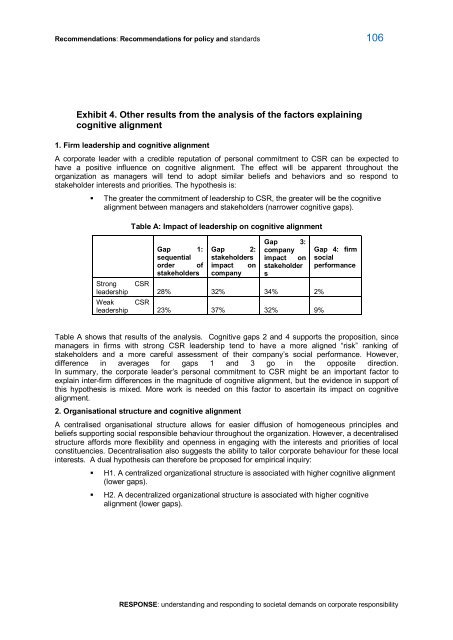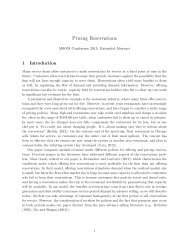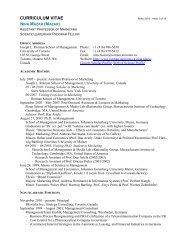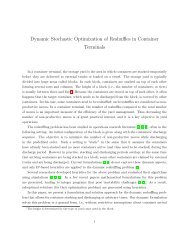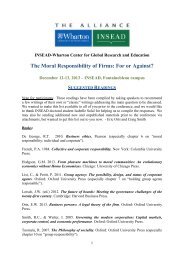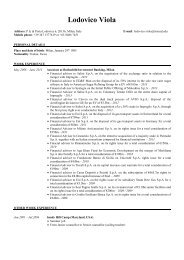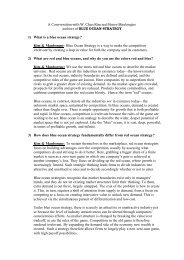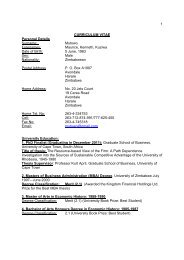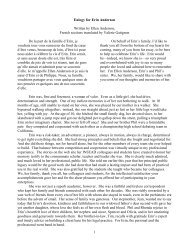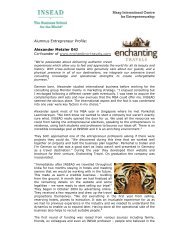RESPONSE - Insead
RESPONSE - Insead
RESPONSE - Insead
You also want an ePaper? Increase the reach of your titles
YUMPU automatically turns print PDFs into web optimized ePapers that Google loves.
Recommendations: Recommendations for policy and standards 106<br />
Exhibit 4. Other results from the analysis of the factors explaining<br />
cognitive alignment<br />
1. Firm leadership and cognitive alignment<br />
A corporate leader with a credible reputation of personal commitment to CSR can be expected to<br />
have a positive influence on cognitive alignment. The effect will be apparent throughout the<br />
organization as managers will tend to adopt similar beliefs and behaviors and so respond to<br />
stakeholder interests and priorities. The hypothesis is:<br />
The greater the commitment of leadership to CSR, the greater will be the cognitive<br />
alignment between managers and stakeholders (narrower cognitive gaps).<br />
Table A: Impact of leadership on cognitive alignment<br />
Gap 1:<br />
sequential<br />
order of<br />
stakeholders<br />
Gap 2:<br />
stakeholders<br />
impact on<br />
company<br />
Gap 3:<br />
company<br />
impact on<br />
stakeholder<br />
s<br />
Strong CSR<br />
leadership 28% 32% 34% 2%<br />
Weak CSR<br />
leadership 23% 37% 32% 9%<br />
Gap 4: firm<br />
social<br />
performance<br />
Table A shows that results of the analysis. Cognitive gaps 2 and 4 supports the proposition, since<br />
managers in firms with strong CSR leadership tend to have a more aligned “risk” ranking of<br />
stakeholders and a more careful assessment of their company’s social performance. However,<br />
difference in averages for gaps 1 and 3 go in the opposite direction.<br />
In summary, the corporate leader’s personal commitment to CSR might be an important factor to<br />
explain interfirm differences in the magnitude of cognitive alignment, but the evidence in support of<br />
this hypothesis is mixed. More work is needed on this factor to ascertain its impact on cognitive<br />
alignment.<br />
2. Organisational structure and cognitive alignment<br />
A centralised organisational structure allows for easier diffusion of homogeneous principles and<br />
beliefs supporting social responsible behaviour throughout the organization. However, a decentralised<br />
structure affords more flexibility and openness in engaging with the interests and priorities of local<br />
constituencies. Decentralisation also suggests the ability to tailor corporate behaviour for these local<br />
interests. A dual hypothesis can therefore be proposed for empirical inquiry:<br />
H1. A centralized organizational structure is associated with higher cognitive alignment<br />
(lower gaps).<br />
H2. A decentralized organizational structure is associated with higher cognitive<br />
alignment (lower gaps).<br />
<strong>RESPONSE</strong>: understanding and responding to societal demands on corporate responsibility


